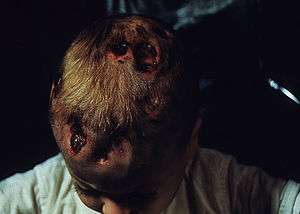Hand–Schüller–Christian disease
Hand–Schüller–Christian disease is associated with multifocal Langerhans cell histiocytosis.
| Hand–Schüller–Christian disease | |
|---|---|
 | |
| A patient with Hand-Schüller-Christian Disease | |
| Specialty | Dermatology |
It is associated with a triad of exophthalmos, lytic bone lesions (often in the skull), and diabetes insipidus (from pituitary stalk infiltration).[1]
It is named for the American pediatrician Alfred Hand Jr.,[2] the Austrian neurologist and radiologist Arthur Schüller,[3] and the American internist Henry Asbury Christian,[4] who described it in 1893,[5] 1915/16[6] and 1919[7]
See also
References
- Kimura T, Ota K, Shoji M, et al. (1990). "Hand-Schüller-Christian disease with occult diabetes insipidus, cardiac failure and renal dysfunction". JPN. J. Med. 29 (4): 405–10. doi:10.2169/internalmedicine1962.29.405. PMID 2148780.
- "Alfred Hand Jr".
- Schindler E. Arthur Schüller: pioneer of neuroradiology. AJNR Am J Neuroradiol 1997; 18: 1297–1302
- Anonymous. Henry Asbury Christian (1876 – 1951). N Engl J Med 1951; 245: 912–913
- A. Hand. Polyuria and tuberculosis. Proceedings of the Pathological Society of Philadelphia, 1893, 16: 282-284. Archives of Pediatrics, New York, 1893: 10: 673-675.
- A. Schüller. Über eigenartige Schädeldefekte im Jugendalter («Landkartenschädel»). Fortschritte auf dem Gebiete der Röntgenstrahlen, 1915-1916; 23: 12-18.
- H. Christian. Defects in membranous bones, exophthalmos, and diabetes insipidus; an unusual syndrome of dyspituitarism. In: Contributions to medical and biological research, dedicated to Sir William Osler. New York, P. B. Hoeber, 1919, 1: 390-401. Medical Clinics of North America, Philadelphia, PA., 1920; 3: 849-871.
This article is issued from
Wikipedia.
The text is licensed under Creative
Commons - Attribution - Sharealike.
Additional terms may apply for the media files.